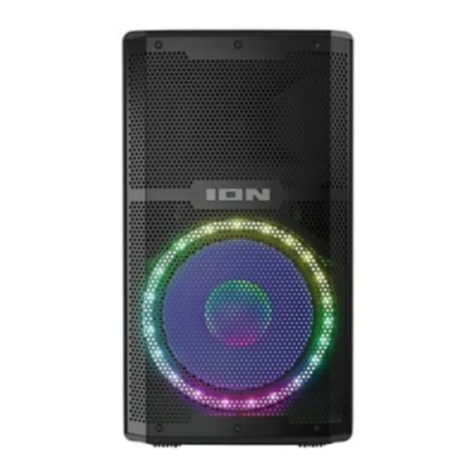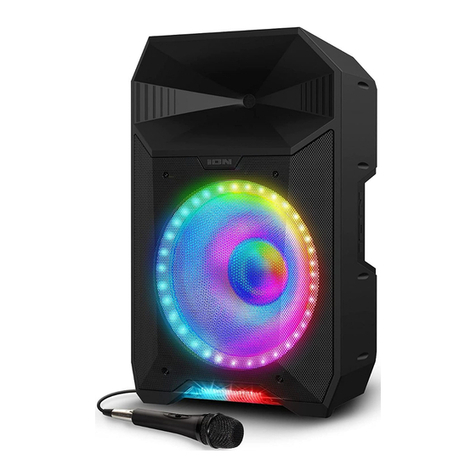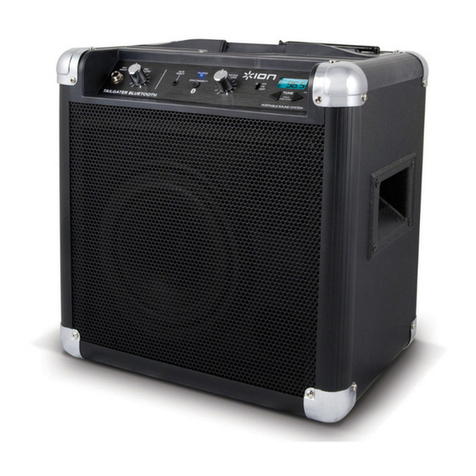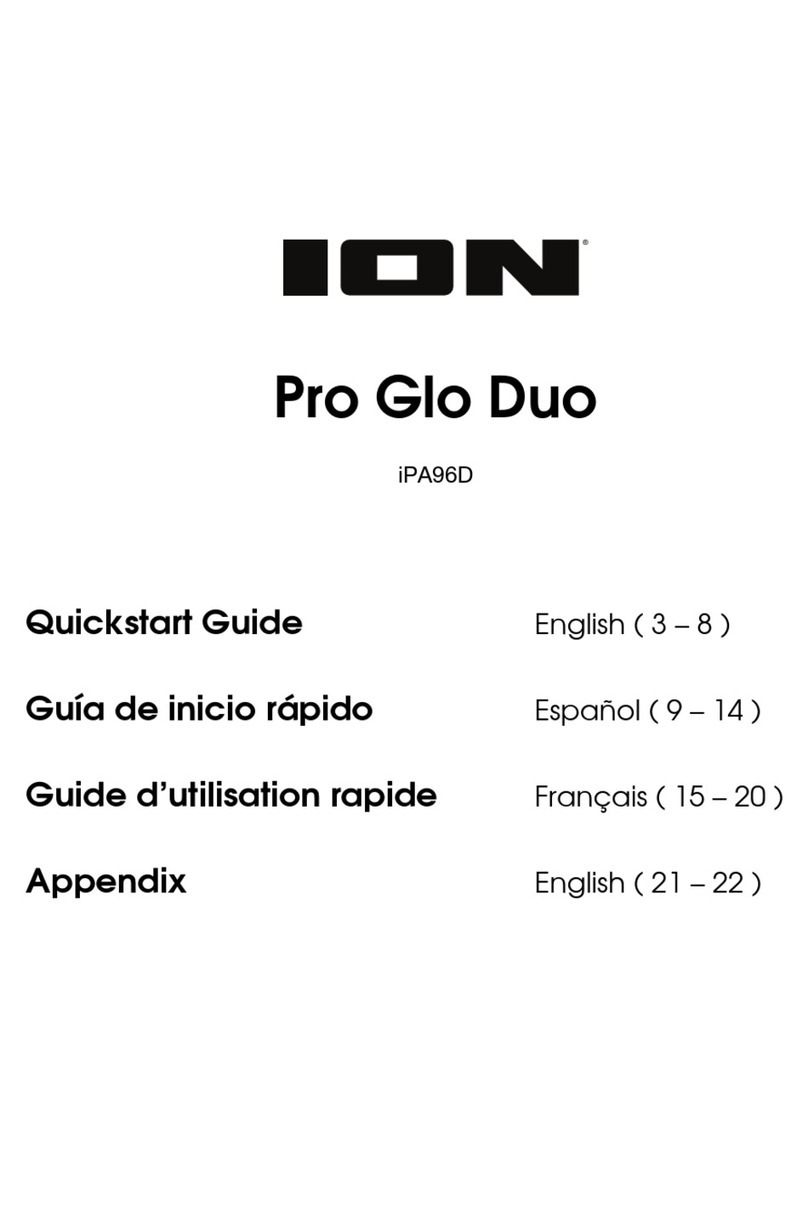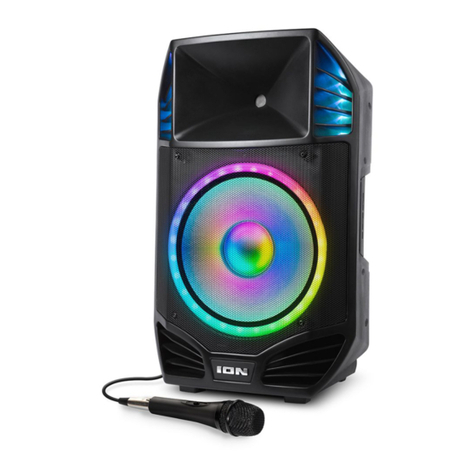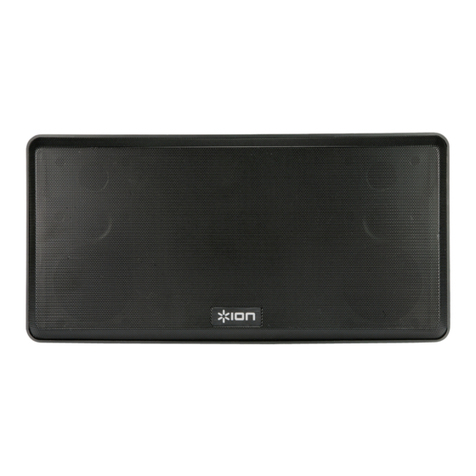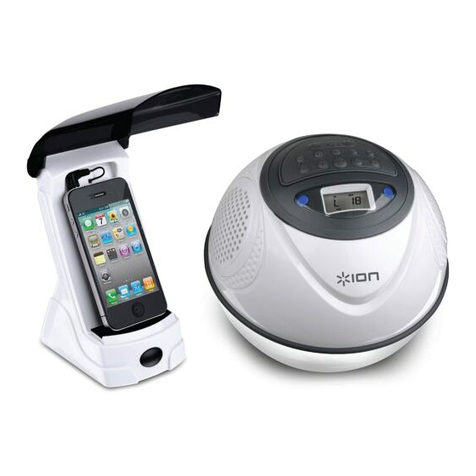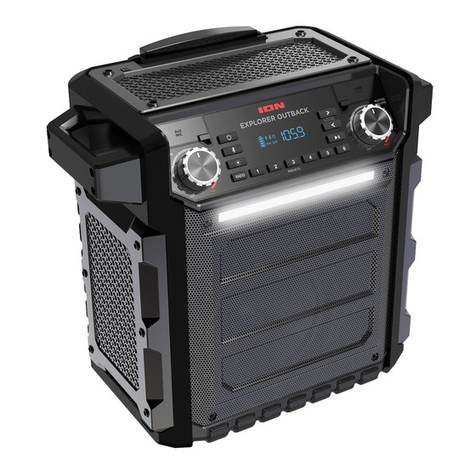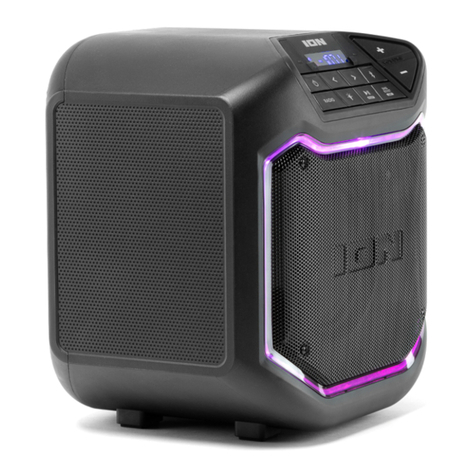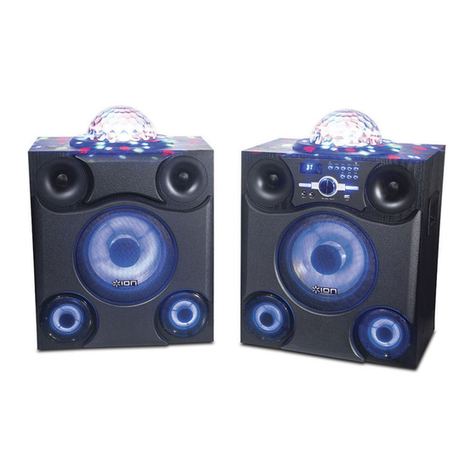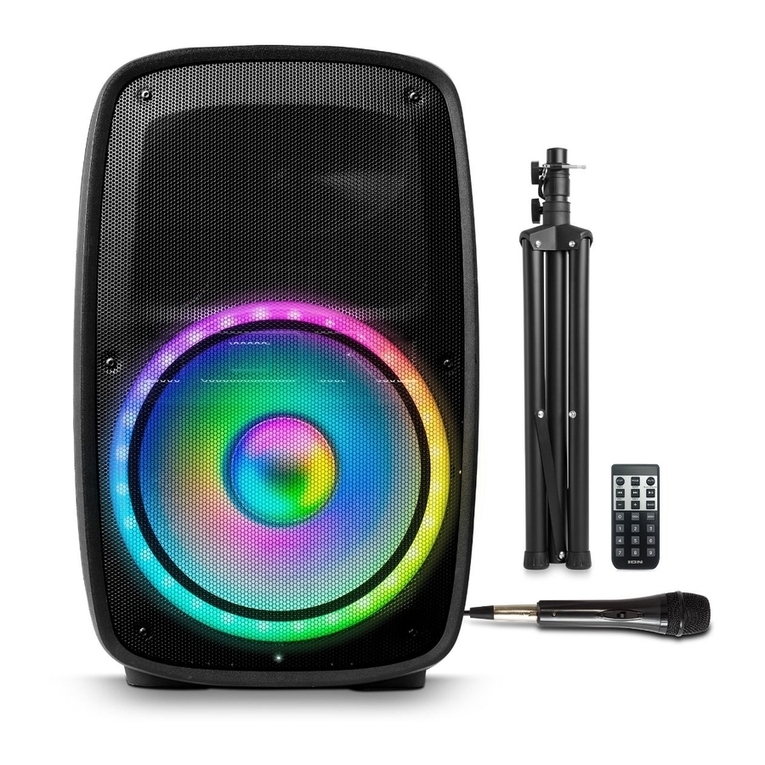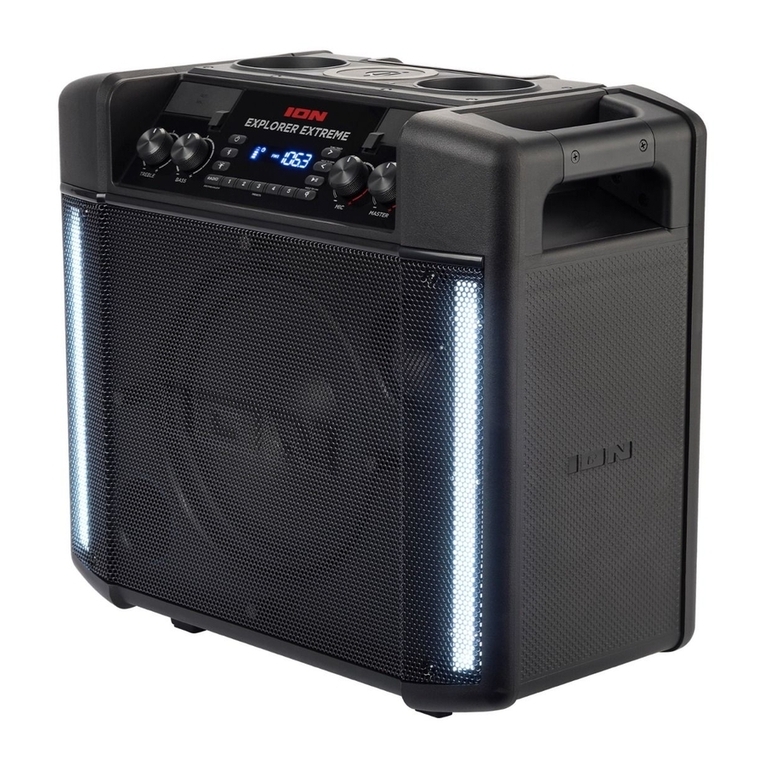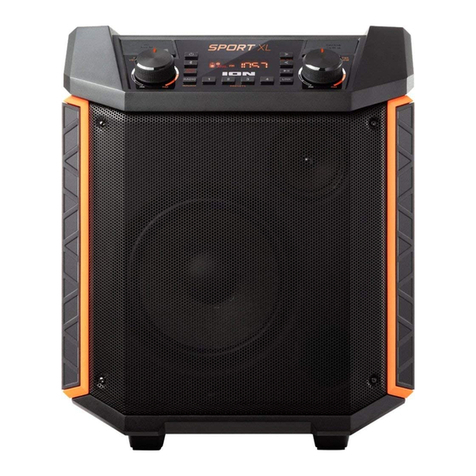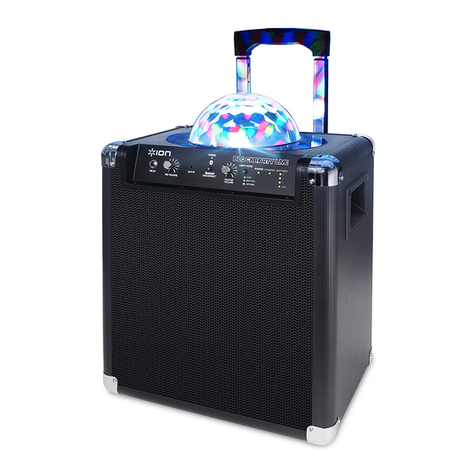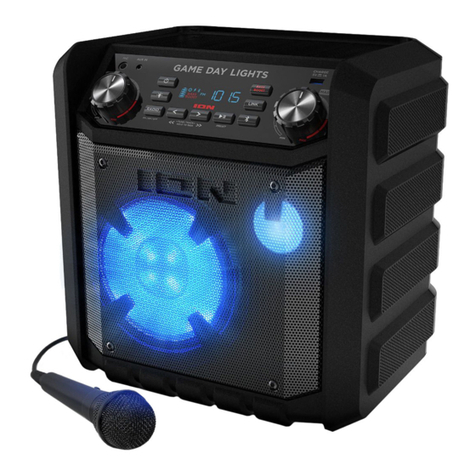
Manual Version 1.2
Trademarks & Licenses
ION Audio is a trademark of inMusic Brands, Inc., registered in the U.S. and other countries. App Store is a trademark of Apple Inc., registered in the U.S. and other countries.
Android and Google Play are registered trademarks of Google Inc. The Bluetooth word mark and logos are owned by the Bluetooth SIG, Inc. and any use of such marks by ION
Audio is under license. All other product names, company names, trademarks, or trade names are those of their respective owners.
Safety & Warranty Information Informations de sécurité et de garantie
English
For complete warranty information: ionaudio.com/warranty
Important Safety Instructions
1. Read and keep these instructions. Heed all warnings and follow all Instructions.
2. Do not defeat the safety purpose of the polarized or grounding-type plug (if applicable). A polarized plug has two
blades with one wider than the other. A grounding type plug has two blades and a third grounding prong. The wide
blade or the third prong is provided for your safety. If the provided plug does not fit into your outlet, consult an
electrician for replacement of the obsolete outlet.
3. Protect the power cord from being walked on or pinched particularly at plugs, convenience receptacles, and the point
where they exit from the apparatus.
4. Use only the cart, stand, tripod, bracket or table specified by the manufacturer, or sold with the apparatus
(if applicable). When a cart is used, use caution when moving the cart/apparatus combination to avoid
injury from tip-over.
5. Unplug this apparatus during lightning storms or when unused for long periods of time.
6. Power Sources (if applicable): This product should be connected to a power supply only of the type described in
these operating instructions, or as marked on the unit.
7. Protective earthing terminal (if applicable): The apparatus should be connected to a mains socket outlet with
a protective earthing connection.
8. For Class II apparatus only (if applicable): This symbol means the equipment is a Class II or double-
insulated electrical appliance. It has been designed in such a way that it does not require a safety connection
to electrical earth.
9. Class II Wiring (if applicable): To reduce the risk of electric shock, the external wiring connected to the terminals with
“Class II Wiring” requires Class II wiring installed by an instructed person or the use of ready-made leads or cords.
10. This apparatus is for professional use only. Intended operational climate: moderate.
11. (If applicable) When moving or not using the appliance, secure the power cord (e.g., wrap it with a cable tie). Be
careful not to damage the power cord. Before using it again, make sure the power cord has not been damaged. If
the power cord has been damaged at all, bring the unit and cord to a qualified service technician for repair or
replacement as specified by the manufacturer.
12. Warning (if applicable):Excessive sound pressure (high volumes) from headphones can cause hearing loss.
13. Warning (if applicable):Please refer to any important information (e.g., electrical, safety, etc.) printed on the
exterior bottom enclosure or rear panel before installing or operating the product.
14. Warning (if applicable): Terminals marked with the lightning bolt symbol may be of sufficient magnitude to
constitute a risk of electric shock.
Safety Notices
CAUTION: TO REDUCE THE RISK OF ELECTRIC SHOCK, DO NOT
REMOVE ANY COVER. NO USER- SERVICEABLE PARTS INSIDE.
REFER SERVICING TO QUALIFIED SERVICE PERSONNEL ONLY.
DANGEROUS VOLTAGE: The lightning flash with arrowhead symbol within the equilateral triangle is intended
to alert the user to the presence of un-insulated “dangerous voltage” within the product’s enclosure that may
be of sufficient magnitude to constitute a risk of electric shock.
INSTRUCTIONS: The exclamation point within the equilateral triangle is intended to alert the user to the presence
of important operating and maintenance (servicing) instructions in the literature accompanying this appliance.
WARNING: To reduce the risk of fire or electrical shock, do not expose this appliance to rain or moisture.
Electrical equipment should NEVER be kept or stored in damp environments.
CAUTION (for U.S.A. & CANADIAN models only): TO PREVENT ELECTRIC SHOCK DO NOT USE THIS (POLARIZED)
PLUG WITH AN EXTENSION CORD, RECEPTACLE OR OTHER OUTLET UNLESS THE BLADES CAN BE FULLY
INSERTED TO PREVENT BLADE EXPOSURE.
NOTICE CONCERNING FCC REGULATIONS: You are cautioned that changes or modifications not expressly approved
by the part responsible for compliance could void the user’s authority to operate the equipment. This equipment has
been tested and found to comply with the limits for a Class B digital device, pursuant to part 15 of the FCC rules. These
limits are designed to provide reasonable protection against harmful interference in a residential installation. This
equipment generates uses and can radiate radio frequency energy and, if not installed and used in accordance with the
instructions, may cause harmful interference to radio communications. However, there is no guarantee that interference
will not occur in a particular installation. If this equipment does cause harmful interference to radio or television reception,
which can be determined by turning the equipment off and on, the user is encouraged to try to correct the interference by
one or more of the following measures: (a) reorient or relocate the receiving antenna; (b) move this unit; (c) increase the
separation between the equipment and receiver; (d) connect the equipment into an outlet on a circuit different from that
to which the receiver is connected; (e) be sure that all cables are properly shielded, using a choke or ferrite where
appropriate; (f) consult the dealer or an experienced radio/television technician for help.
This device complies with Part 15 of the FCC rules. Operation is subject to the following two conditions: (1) this device
may not cause harmful interference, and (2) this device must accept any interference received, including interference that
may cause undesired operation.
FCC Radiation Exposure Statement:This equipment complies with FCC radiation exposure limits set forth for an
uncontrolled environment. This equipment should be installed and operated with a minimum distance of 20 cm between
the radiator and your body.
For Canadian Models:
•This device contains licence-exempt transmitter(s)/receiver(s) that comply with Innovation, Science and Economic
Development (ISED) Canada’s licence-exempt RSS(s). Operation is subject to the following two conditions: (1) this
device may not cause interference, and (2) this device must accept any interference, including interference that may
cause undesired operation of the device.
•Under ISED regulations, this radio transmitter may only operate using an antenna of a type and maximum (or lesser)
gain approved for the transmitter by ISED. To reduce potential radio interference to other users, the antenna type and
its gain should be so chosen that the equivalent isotropically radiated power (e.i.r.p.) is not more than that necessary
for successful communication.
•This radio transmitter (identify the device by certification number, or model number if Category II) has been approved by
ISED to operate with the antenna types listed below with the maximum permissible gain and required antenna
impedance for each antenna type indicated. Antenna types not included in this list, having a gain greater than the
maximum gain indicated for that type, are strictly prohibited for use with this device.
•This unit does not exceed the Class B limits for radio noise emission from digital apparatus set out in the radio
interference regulations of the Canadian Department of Communications.
•This device operates on a no-protection, no-interference basis. Should the user seek to obtain protection from other radio
services operating in the same TV bands, a radio licence is required. For further details, consult Innovation, Science and
Economic Development Canada’s document Client Procedures Circular CPC-2-1-28, Voluntary Licensing of Licence-
Exempt Low-Power Radio Apparatus in the TV Bands.
Français
Pour obtenir toutes les informations relatives à la garantie : ionaudio.com/warranty
Instructions importantes de sécurité
1. Lire et conserver les instructions qui suivent. Respecter tous les avertissements et suivre toutes les instructions fournies.
2. Ne pas casser l’élément de sécurité de la fiche polarisée ou de mise à la terre (le cas échéant). Une fiche polarisée
est dotée de deux lames, une étant plus large que l’autre. Une fiche de mise à la terre est dotée de deux lames et
d’une broche de mise à la terre. La lame plus large ou la troisième broche est pour votre sécurité. Si la fiche ne
s’insère pas dans la prise murale, consulter un électricien pour qu’il vienne remplacer la prise adéquate.
3. Protéger le câble d’alimentation de sorte à ne pas pouvoir marcher dessus ou à coincer les fiches au niveau des
connexions et au point de sortie de l’appareil.
4. Utiliser uniquement un socle, un support, un trépied, une console ou une table recommandés par le
fabricant ou vendus avec l’appareil (le cas échéant). Lorsqu’un socle est utilisé, déplacer l’ensemble
appareil-socle avec soin pour éviter de le faire basculer.
5. Débrancher l’appareil durant les orages ou lorsque non utilisé pendant de longues périodes.
6. Sources d’alimentation (le cas échéant) : Cet appareil doit être alimenté uniquement par le type de source de
courant indiqué dans le guide d’utilisation, ou tel qu’indiqué sur le produit.
7. Borne de terre de protection (le cas échéant) : Par mesure de sécurité, l’appareil doit être branché à une
prise de courant comprenant une borne de mise à la terre.
8. Pour appareil de classe II seulement (le cas échéant) : Ce symbole signifie que l’appareil est de classe
II ou possède une double isolation électrique. Il est conçu de manière à ce que l’utilisation d’une prise de
terre ou de masse n’est pas requise.
9. Câblage de classe II (le cas échéant) : Afin de réduire le risque de décharge électrique, le raccordement du
câblage externe aux bornes marquées « câblage de classe II » ne doit être effectué qu’avec du câblage de classe II
par une personne compétente ou en utilisant des câbles appropriés.
10. Cet appareil est destiné à un usage professionnel. Climat opérationnel prévu : modéré.
11. (Le cas échéant) Veillez à toujours fixer le câble d’alimentation lors du déplacement de l’appareil ou lorsqu’il n’est
pas utilisé. Veillez à ne pas endommager le câble d’alimentation. Vérifiez toujours le câble d’alimentation avant
d’utiliser l’appareil. Si le câble d’alimentation est endommagé de quelconque façon, faites vérifier l’appareil et le
câble d’alimentation par un technicien qualifié recommandé par le fabricant afin de les faire réparer ou replacer.
12. Mise en garde (le cas échéant) : Afin de prévenir toute lésion de l’appareil auditif, évitez d'écouter de la
musique à un volume élevé pendant de longues périodes.
13. Mise en garde (le cas échéant) : Veuillez vous reporter aux importantes informations (p. ex., informations
électriques, de sécurité, etc.) imprimées sur le dessous ou le panneau arrière de l’unité avant de procéder à son
installation ou à son utilisation.
14. Mise en garde (le cas échéant) : Los terminales marcados con el símbolo de relámpago pueden ser de
suficiente magnitud como para presentar un riesgo de choque eléctrico.
Avis de sécurité
CAUTION : POUR REDUIRE LE RISQUE DE CHOQUE ELECTRIQUE
N’ELOIGNEZ PAS LA COUVERTURE. PAS DE COMPONENTS
UTILISABLES AU SERVICE A L’INTERIEUR. DEMANDEZ SERVICE
SEULEMENT AU PERSONNEL QUALIFIE.
VOLTAGE DANGEREUX : QUAND LE FLASH AVEC LE SYMBOLE D’UNE FLECHE DANS LE TRIANGLE
EQUILATERAL EST ALLUME IL SIGNALE LA PRESENCE D’UN « VOLTAGE DANGEREUX » DANS LE
PRODUIT QUI EST SUFFISANT POUR CONSTITUER UN RISQUE DE CHOC ELECTRIQUE.
INSTRUCTIONS : Le signe d’exclamation dans le triangle équilatéral signale à l’utilisateur la présence des
instructions importantes pour le fonctionnement et la maintenance de ce produit.
MISE EN GARDE : Afin de réduire les risques d’incendie ou d’électrocution, ne pas exposer cet appareil à
la pluie ou à l’humidité. Tout équipement électrique ne devrait jamais être placé ou remisé dans un
environnement humide.
POUR LES MODÈLES AMÉRICAINS ET CANADIENS SEULEMENT : POUR ÉVITER TOUT RISQUE ÉLECTROCUTION,
NE PAS UTLISER CETTE FICHE POLARISÉE AVEC UN PROLONGATEUR, UNE PRISE DE COURANT OU UNE AUTRE
SORTIE DE COURANT, SAUF SI LES LAMES PEUVENT ÊTRE INSERRÉES À FOND SANS EN LAISSER AUCUNE PARTIE
À DÉCOUVERT.
AVIS CONCERNANT LA RÉGLEMENTATION FCC (Commission Fédérale américaine des Communications ou
CCE) : Cet équipement génère et utilise de l’énergie sur des fréquences radio et peut causer des interférences à la
réception des programmes radio et télévision si vous ne l’utilisez pas dans une stricte concordance avec les
procédures détaillées dans ce guide de fonctionnement. Cette unité est conforme aux normes de Classe B en accord
avec les spécifications des sous paragraphe J ou de l’article 15 de la réglementation FCC, qui sont désignées à offrir
une protection raisonnable contre de telles interférences dans une installation résidentielle. Toutefois, il n’est pas
garanti qu’aucune interférence n’apparaisse dans des installations particulières. Si l’unité cause des interférences avec
la réception de la radio ou de la télévision, vous pouvez essayer de les corriger en utilisant une ou plusieurs des
mesures suivantes : (a) repositionnez l’autre appareil et/ou son antenne, (b) déplacez cet appareil, (c) éloignez cet
appareil le plus loin possible de l’autre appareil, (d) branchez cet appareil dans une autre prise AC, de cette façon, ils
seront sur des circuits différents ou (e) assurez vous que tous les câbles soient blindés à l’aide d’une bobine d’arrêt ou
ferrite, où nécessaire. Cet avis est conforme à l’article 15.838 de la réglementation FCC.
Le présent appareil est conforme aux l’article 15 de la réglementation FCC. L’exploitation est autorisée aux deux
conditions suivantes : (1) l’appareil ne doit pas produire de brouillage, et (2) l’utilisateur de l’appareil doit accepter tout
brouillage radioélectrique subi, même si le brouillage est susceptible d’en compromettre le fonctionnement.
Déclaration de la FCC sur l’exposition aux rayonnements : Cet appareil est conforme aux limites d’exposition au
rayonnement de fréquence radio de la FCC établies pour un environnement non contrôlé. Cet appareil doit être installé
et utilisé en respectant une distance minimale de 20 cm entre l’élément rayonnant et le corps humain.
Pour les modèles Canadiens :
•L'émetteur/récepteur exempt de licence contenu dans le présent appareil est conforme aux CNR d’Innovation,
Sciences et Développement économique Canada (ISDE) applicables aux appareils radio exempts de licence.
L’exploitation est autorisée aux deux conditions suivantes : (1) l’appareil ne doit pas produire de brouillage, et (2)
l’utilisateur de l’appareil doit accepter tout brouillage radioélectrique subi, même si le brouillage est susceptible
d’en compromettre le fonctionnement.
•Conformément à la réglementation d’ISDE, le présent émetteur radio peut fonctionner avec une antenne d’un
type et d’un gain maximal (ou inférieur) approuvé pour l’émetteur par ISDE. Dans le but de réduire les risques de
brouillage radioélectrique à l’intention des autres utilisateurs, il faut choisir le type d’antenne et son gain de sorte
que la puissance isotrope rayonnée équivalente (p.i.r.e.) ne dépasse pas l’intensité nécessaire à l’établissement
d’une communication satisfaisante.
•Le présent émetteur radio (identifier le dispositif par son numéro de certification ou son numéro de modèle s’il fait
partie du matériel de catégorie I) a été approuvé par ISDE pour fonctionner avec les types d’antenne énumérés
ci-dessous et ayant un gain admissible maximal et l’impédance requise pour chaque type d’antenne. Les types
d’antenne non inclus dans cette liste, ou dont le gain est supérieur au gain maximal indiqué, sont strictement
interdits pour l’exploitation de l’émetteur.
•Cet appareil n’excede pas les limites de la Classe B pour les émissions des fréquences radio à partir d’un
appareil numérique établit par le Ministère des communications.
•Cet appareil fonctionne sur une base de non-brouillage et sans garantie de protection. Dans le cas où l’utilisateur
cherchera à obtenir une protection contre le brouillage produit par les autres services radio fonctionnant sur les
mêmes bandes de télévision, une licence radio est nécessaire. Pour de plus amples détails, veuillez consulter la
circulaire des procédures concernant les clients CPC-2-1-28, intitulée Délivrance de licences sur une base
volontaire pour les appareils radio de faible puissance exempts de licence et exploités dans les bandes de
télévision d’Innovation, Sciences et Développement économique Canada.
